Chris Grinter, on July 1st, 2010 A nyní k ještě méně často se opakujícím sériím, Hlas lidu! Pro ty, kteří nemají zjizvené vzpomínky na středoškolské hodiny latiny (bez viny mého učitele) Uvedu vás do tempa – název zhruba znamená “hlas lidu”. Zde je další starý e-mail, který jsem si ukládal. Je to a 100% skutečné poselství, ale samozřejmě jsem zredigoval skutečná jména a adresy, abych chránil nevinné. Užívat si! Velmi doporučuji také vaše vlastní příspěvky-
Zimní 2008:
“Ahoj, Jsem moc rád, že jsem tě našel. Nyní, Doufám, že mi pomůžete. 1982, při kempování ve starém táboře pro těžbu zlata v národním lese Mendocino mě kousl velký hnědý pavouk. Trvalo tři dny, než jed prošel mým systémem. Třetí den jsem byl 95% slepý, kousnutí se zvětšilo do velkého groteskně tmavě červeného hrbolu na mé paži. nikdy nezapomenu na 12 hodin na mě zaútočil jed. Cena, kterou jsem zaplatil za přežití tohoto pavoučího jedu, byla…….ztratit úplně všechen svůj tělesný tuk. Mluvil jsem telefonicky s lékařem ze Santa Rosy od přátel (nějaké malé město CA). Věděl o tomto pavoukovi a nemohl uvěřit, že jsem ten jed přežil, když jsem mu řekl, že jsem ztratil veškerý tělesný tuk. Také mi řekl, že je nemožné, aby někdo přežil, když ztratil veškerý tělesný tuk 12 hodiny. Připomněl jsem mu, že to je nemožná situace. Řekl mi, že tento pavouk je držen před veřejností. Věřím, že tento pavouk pochází z Číny nebo Ruska. Tito pavouci nic nesdílejí s jinými pavouky Cali. Mají velká těla a krátké silné nohy. Žena, která mě kousla, byla asi 4 palce a, měl 5 muži. O čtyři roky později, když žil v Hayward Hills, Nevěřil jsem svým očím, běží po podlaze, další. Tento pavouk byl o 6 palce. Vím, že tito pavouci nešplhají po stěnách ani netočí sítě. Staví hnízda, a získat 4-5 muži, aby ji chránili a našli potravu. Samice nikdy neopouští hnízdo kromě…………když ji vyžene větší samice a, zabíjí její samce. To je, když jsou lidé kousnuti tímto pavoukem, když pobíhá a hledá další hnízdo. Kousnutí jsou velmi vzácná. přemýšlel jsem………….jak velká byla žena, která to řídila 6 palec od jejího hnízda. A………….jak jsou velké. Mohu najít tohoto pavouka vystaveného na (vaše muzeum)? Je možné najít všechny jejich informace o tomto velmi nebezpečném pavoukovi??”
Continue reading Vox Populi, Objem II
Chris Grinter, on June 26th, 2010 Welcome to volume eight of the inconsistently reoccurring series, Genius z tisku. Narazil jsem na tento článek recently regarding an endemic Puerto Rican butterfly. Who can tell me exactly why this report is misleading? It may be a little trickier than the standard GOP (I suggest discarding any previously associated acronyms with those letters). Hint, just telling me the butterfly in the picture is from Malaysia is not the answer I’m looking for!
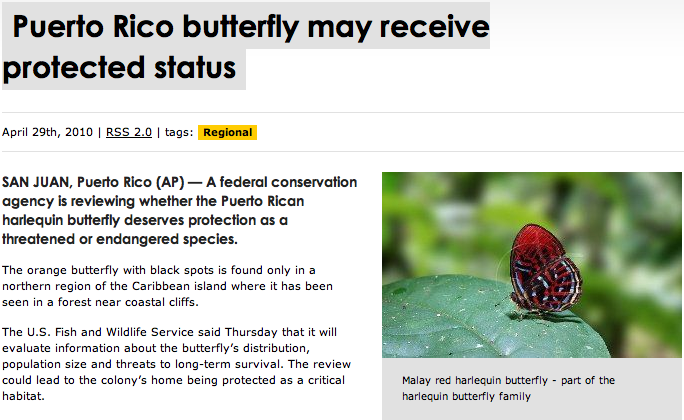
Chris Grinter, on June 23rd, 2010 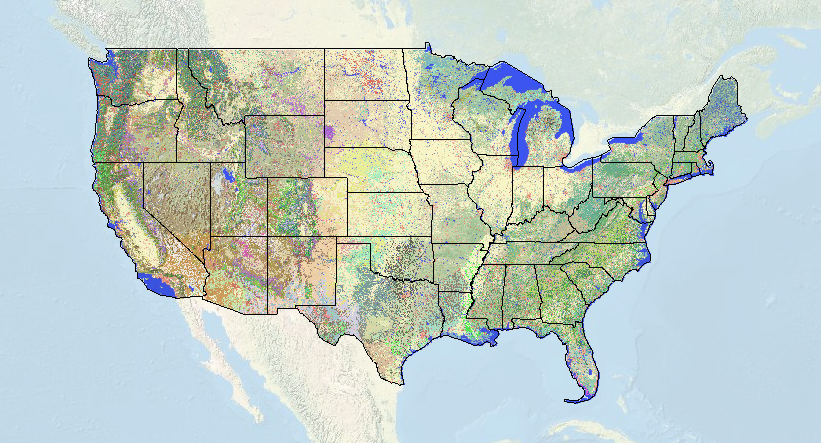
I’ve always wondered how to find the correct terminology for land cover in a given area. Usually, I just ballpark something along the lines of “oak chaparral”. But now I can use this awesome new map brought to us by the USGS/National Biological Information Infrastructure. The level of detail is amazing, and you can specify the degree of accuracy with a drop down tab (1-3). Now with a high-def US topo map I can see exactly where the largest stands of monterrey pine are (actually it’s a California Coastal Closed-Cone Conifer Forest and Woodland) so I can optimally place my trap this weekend.
Continue reading Landscape Cover Map
Chris Grinter, on June 18th, 2010 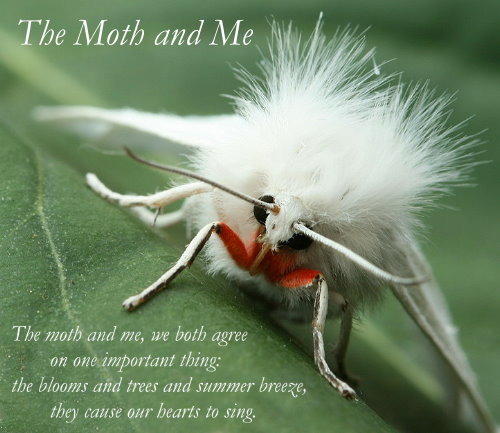
Welcome to The Moth and Me #12, and my first blog carnival. Despite blogging for a few months I have yet to take a look back and reflect on exactly how I became enamored with lepidoptera in the first place. Remembering a time or location where this happened is impossible, and like many of my colleagues and I’m sure many of my readers, I had a butterfly net and “bug cage” in hand as soon as I could walk. When it comes to entomology I believe almost everyone falls in love at first with a large and striking insect. For me it was a butterfly, naturally. I can remember staring for endless hours at the diversity of Ornithoptera and Papilio illustrated in Paul Smart’s famous book. Somewhere along the way in pursuit of something new I began to stray into the nocturnal world. Moths comprise the majority of the diversity of Lepidoptera; while there are nearly 11,000 species in the United States, only a few hundred are butterflies. This quickly opened a door (maybe into an abyss…) to the shocking abundance found everywhere around us. This amazing diversity has now drawn me deep into the biology and evolutionary history of the Lepidoptera. Editing these fourteen contributions of moth blogging together I just can’t help but to reflect back on some of my own mothing journey.

Perhaps if I was a child in Europe this moth (Deilephila elpenor porcellus) would have been the first to catch my eye. Over at Urban Moths Ron Laughton has discovered the stunning diversity in his own back yard in much the same way as I did growing up here in the US. Take a look at the types of traps he has been using, most of which he constructed himself. One of the best behaviors of moths is their willingness to dive headlong into the light. Not too far from Ron, Mike Beale has been blogging british moths as well. It can be pretty amazing just how similar our two faunas are (a few moths actually are the same).
Continue reading The Moth and Me #12
Chris Grinter, on June 11th, 2010 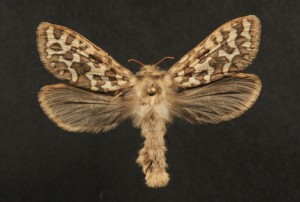
This moth is just about as rare as its paranormal namesake (except that it’s real) – it’s a Gazoryctra sp. in the family Hepialidae. They represent a basal lineage of the Lepidoptera and are commonly known as ghost moths or swift moths. Ghost – because males of some species are known to fly in true leks, where they hover up and down in grassy clearings at dusk while females observe. These same males also call for females with pheromones, a bit of a backward situation with insects. Swift- rather self evident, but boreal species have been known to be powerful flyers.
One of the features that help indicate this as a basal lineage is the placement of the wings on the body, some wing venation, reduced or absent mouthparts and the lack of a strong wing coupling device. These moths have a “jugum”, which is a small thumb like projection from the top of the hindwing. Other lineages of moths have a tight coupling mechanism known as the frenulum and retinaculum, where bristles hook the two wings together so they remain coupled during flight. When at rest the jugum folds around and probably helps keep the wings together – but not while in flight; the forewing is out of sync with the hindwing and flight is not dynamic (Scoble 1992).
In the Americas Hepialid biology is very poorly understood. Only a handful of life histories are described globally – all of which seem to be endophagous (boring) in plant root systems. Some early instar larvae may feed in the leaf litter or underground on the root system before entering the rhizome. Australia is fortunate to have a diverse and impressive fauna of Hepialidae – many are brilliantly colored and enormous (250mm or up to 12 palců!), and a bit better studied. Some larvae are even common enough that aboriginal tribes have used them as a staple food source.
But back to this moth in particular. I collected it in my black light trap last August up in the Sierra Nevada around 10,500 feet. The species is unknown, and may likely be new. The most frustrating part is that it is the only specimen known to science. The entire genus is very rare, except for one or two commoner species, only a few dozen specimens exist. So is it a female of a species described only from a male? A freakish aberration of an otherwise known species? Or maybe it is actually new. I’ve barcoded the DNA, that actually tells me nothing since there are zero sequences from any closely related species. Ve skutečnosti, as far as I know, the other species in the Sierra haven’t even been collected in decades so I can’t even get a sequence from an older specimen. The icing on the cake is their behavior. They rarely, pokud vůbec, come to light – which may be a result of their crepuscular flight. On the right night they may be on the wing for 20-30 minutes, usually a female searching out a male, or a female flying to oviposit (likely just broadcast scatter their eggs on the ground). So come this late August I’ll be returning to the high Sierra with a few volunteers from the entomology department in hopes of seeing one whiz by me on the steep slopes. If I get some more, it might turn out to be impressive new species for California.
Chris Grinter, on June 11th, 2010 Who can see what’s wrong with tento článek?

Chris Grinter, dne 9. června, 2010 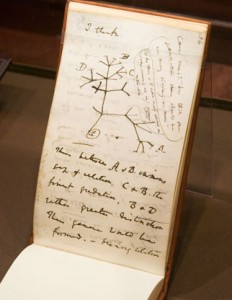
Tento nedávný článek v American Naturalist se podruhé podíval na některé ze skvěle nafouknutých odhadů druhů, někteří jdou vysoko jako 100 milión (Erwin, 1988). Odhady provedené autory naznačují výše uvedené projekce 30 miliony mají pravděpodobnost <0.00001. Jejich odhadovaný rozsah bude pravděpodobněji mezi 2.5 a 3.7 milionů druhů (s 90% důvěra). To se zdá být poněkud rozumné vzhledem k tomu, že tyto mimořádné odhady byly silně založeny na extrapolaci. Při posuzování diverzity na základě průzkumů tropických členovců je zjevně mnoho obtíží – tento článek opět používá fytofágy (požírání rostlin) brouci pro odhady. Pečlivě poukazují na to, že tyto metody neberou v úvahu nefytofágní hmyz, ale předpokládají, že budou následovat tradiční biogeografické vzorce diverzity. Toto je poněkud nový koncept, protože když jsem byl na vysoké škole, učili mě, že parazitoidy jsou kontraintuitivní není rozmanitější v tropických oblastech. Tato hypotéza se ve světle přesnější moderní taxonomické metodologie častěji než neprokáže jako nepravdivá. Spíše jsem hrdě pomáhal hrát roli s parazitoidní projekt na UIUC. Stručně řečeno, specifičnost hostitele je extrémnější v tropickém prostředí se stovkami kryptických druhů skrytých mezi rychle se šířícími skupinami, jako jsou mikrogastriní Braconids (Hymenoptera) – totéž platí pro podobné taxony.
Zajímavou poznámkou k článku je jejich zahrnutí sekundárního odhadu založeného na sestavách baldachýnu Lepidoptera. Předpokládali, že a) všechny Lepidoptera lze nalézt v korunách stromů a b) že všechny lep jsou fytofágní. Toto je jasně velmi konzervativní odhad vzhledem k tomu, že ne všichni Lepidoptera se nacházejí v korunách stromů a ne všichni jsou fytofágní. Zatímco čísla nemám po ruce, určité procento diverzity lep muselo být z těchto odhadů vyloučeno. Taky vyjdu na hubu a budu předpokládat, že autoři (Novotný 2002) nezahrnoval morfospecies microlepidoptera – a s největší pravděpodobností odhadované abundance s naším současným taxonomickým chápáním. K tomu však nemám přístup 2002 papír, takže se mohu mýlit. Pomocí těchto čísel Lepidoptera (ze stejného průzkumu jako Coleoptera) globální diverzitu odhadli Hamilton et. al. kolem 8.5 miliony druhů členovců.
I když souhlasím, že mimořádné odhady v řádu desítek desítek (nebo stovky) milionů druhů členovců jsou pravděpodobně směšné; Jsem z toho tábora, že současný výzkum naznačuje, že jsou možné odhady nižších desítek milionů druhů. Autoři nezahrnuli výzkum, který by vyvažoval jejich předpoklad, že tropické druhy vykazují nižší beta diverzitu (Novotný 2002, 2007). Ve stejném deníku, Příroda 2007, Dyar et. al. naznačili, že americké tropy vykazují vyšší beta diverzitu, než se dříve předpokládalo. Buď lze říci, že odhady diverzity beta v australských tropech jsou nesprávné, nebo jsou neslučitelné s druhovými společenstvy neotropických lesů. To vše svědčí o obtížnosti extrapolace odhadů druhů ve všech tropických oblastech. Tyto odhady jsou založeny na komplexních průzkumech hmyzu na Nové Guineji, možná přesně neodrážejí skutečnou rozmanitost amerických tropických pralesů, a tato číselná rozmezí jsou nízká.
Jako poslední myšlenka, většina hodnocení je zaměřena na tropické členovce. Zdá se až příliš možné, že celkový počet všech druhů, včetně bakterií a archeí, může snadno přesáhnout desítky milionů. Ale extrapolace těchto čísel je ještě nejistější než u členovců, vzhledem k extrémnímu nedostatku znalostí, které máme.
Chris Grinter, on June 4th, 2010 
Can’t find a way to link the direct video (not even VodPod), but here is the link to the Daily Show site. How many physicists pulled their hair out when they heard this one? Fuj, he is the newly appointed spokesman. Don’t worry Neil, you’re not going anywhere after this.
Having not aired yet I can’t tell exactly how apologetic the show je, but it seems heavily focused on finding the “creator”. I can hear it in John Stewart’s voice when he pulls back from ripping into Freeman’s “god of the gaps” theory. Perhaps there was an edit and we missed the question where John Stewart asked “Morgan, can you define a logical fallacy for us… perhaps the god of the gaps one?” I believe that any physicist who ever says “god was responsible” says it with no deeper meaning than when Einstein famously evoked god’s dice. That’s to say, a non-literal and non-personal god found only in the beauty and splendor of nature.
Chris Grinter, on June 2nd, 2010 
If there is one thing that I learned in college, it was how to easily distract myself. I tend to keep my TV on in the background while I’m working on my computer, especially late at night when I am usually fighting a winning war against sleep. The other night something did catch my eye: a man holding dowsing rods in his back yard. Volume up, let the bullshit flow. It was just a flash of idiocy in an otherwise good program on home improvement. I’ve become accustom to crap-based TV on networks such as the History Channel or a Discovery network (quality of their shows include gems like “The Haunted: ghosts and pets”), but I was a little surprised to see BS grace my local PBS station.
Over on the “American Woodshop” host Scott Phillips was constructing a beautiful garden arbor. You can watch the entire thing here for free: Episode 1609: Period Architectural Moldings and Trim. There are no time stamps on the clip, but the dowsing comes in around the mid-point. While demonstrating the materials needed to secure the wood to the ground he cautioned against digging haphazardly into your yard without knowing where the underground water, electrical or gas lines were: solid advice. So in order to do this you should (paraphrased) “take pieces of coat-hanger, anything will do, turn them into an “L”. As I walk forward the bars cross – tam (they cross) – right there is the irrigation line. 9 out of 10 people have this ability, but you should call in a professional if there is any doubt“. My translation “OK guys, don’t worry about calling in some guy to do this, figure it out this way”. Please tell me what man who seriously watches a home improvement show at midnight would cede authority to someone else before giving it the good ol’ college try? Even if we grant for a moment that 9 out of 10 people could do this, what about that one guy who can’t? Isn’t it irresponsible to suggest that you can avoid power/water/sewer/gas only 90% času? Chybička se vloudila, hit that pesky gas line…
Being a scientist, a skeptic and a procrastinator – I wrote Scott a message about this so I could avoid my work at hand. Today he kindly replied saying: (excerpt)
“Our bodies are electromagnetic fields. Disrupt a field and things happen…. I learned the technique mentioned from a city worker that they used to find lines. Not from a charlatan. My team witnessed the objective use of this technique.”
Briefly, ne, our bodies are not electromagnets. Everyone can hold a compass, or TV… without screwing them up. Franz Mesmer coined the idea of “Animal Magnetism” in the last half of the 18th century (also invented “mesmerization” AKA hypnotism) – and had it abruptly debunked by Benjamin Franklin and others. I’m also a bit worried to hear that city workers are relying on dowsing to locate public lines! But to move onward, let us dig into the myths of dowsing. I agree that there seems to be somewhat of an intuitive truth when it comes to dowsing, however false it is scientifically, it remains compelling. Tak určitě… electrical things underground effect sensitive wires above. And wow, look at all these guys who can find water, or power, nebo… lost people… nebo bombs? OK, let’s stick to water for this conversation.
(continued)
Continue reading An Uphill Battle
Chris Grinter, 1. června, 2010 Just a few images of common California leps, taken along the coast range near Santa Cruz a few weeks ago. Starting to work my way through some photo backlog…

Euphydryas chalcedona
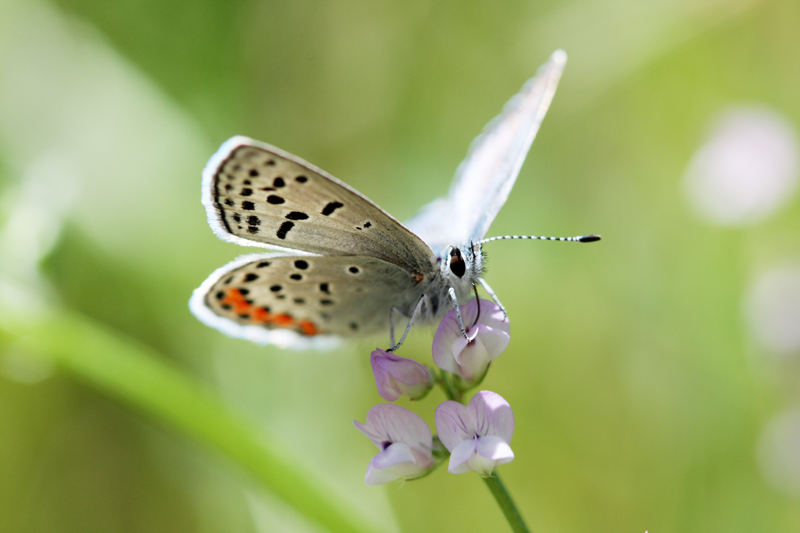
Plebejus Acmon
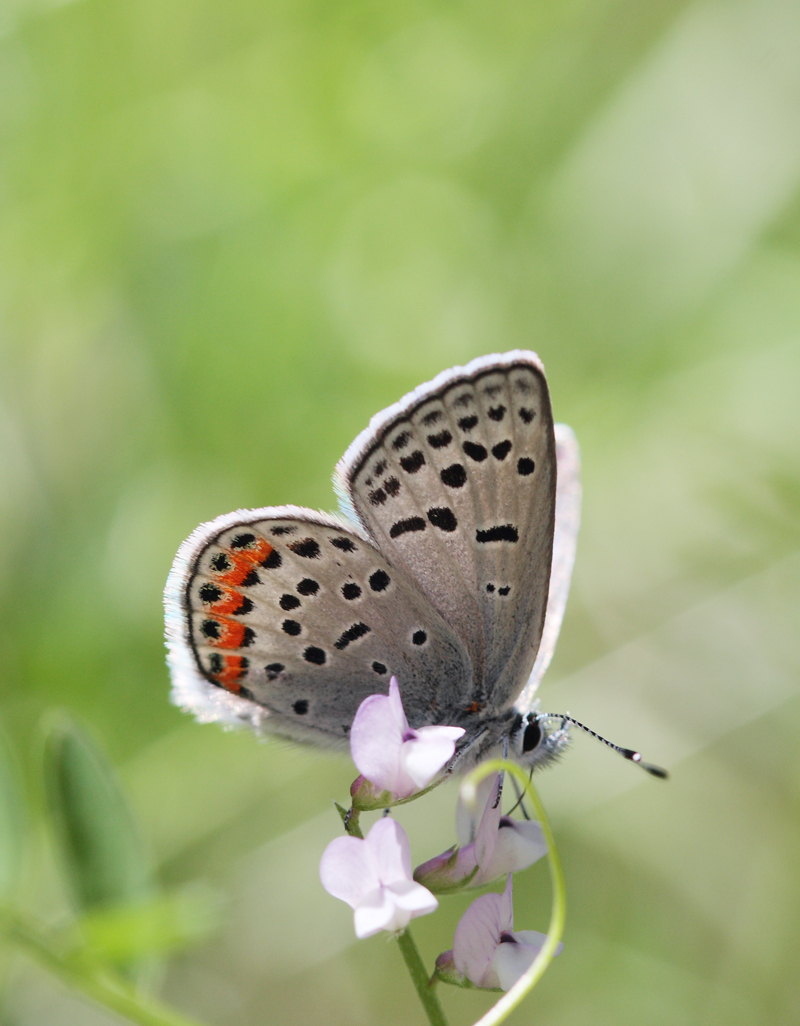
Plebejus Acmon

Ethmia arctostaphylella na Eriodictyon sp.
One interesting note on Ethmia arctostaphylella – the name is a misnomer, it does not actually feed on Arctostaphylos (Manzanita). At the time of description in 1880 Walsingham had found larvae pupating on leaves of manzinata and assumed it was their host plant. In Jerry Powell’s stunning monograph of the group he indicates this moth was reared from Eriodictyon – which happens to be the flower the moth is perched on. The two plants grow side by side, and it’s pretty easy to see how a wandering caterpillar finds its way onto a neighbor.
|
Skepticismus
|













